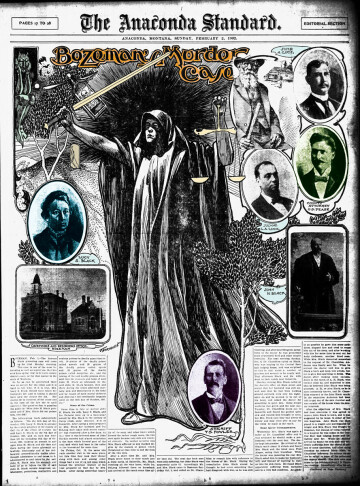Death By Poison!
Kelly Hartman | Friday Oct. 1st, 2021
The front page of the October 12, 1901 Avant Courier bared the headline “Death by Poison!” It was apparent immediately that the death had been no accident. According to the subheading, this had been the second time that John H. Black, a prominent citizen of Salesville, had been poisoned, but this time the result had been fatal. The headline alone would have been enough to spark anyone’s interest in the case as most murders in the area were the result of gunshot or knife wounds. However, fascination would grow when the last paragraph of the article breaking the news stated that the wife of Mr. Black, Lucy, and a hired man, Fred Auger, had been arrested on suspicion.
It seems the first attempt at poisoning had been made in August over a dinner of ham. Mr. and Mrs. Black and Ira DeLong (also of Salesville) had eaten together at Mrs. Black’s homestead near Camp Creek. At the time, it had been believed that the ham had been poisoned as it had “been left in the unoccupied house for some time.” It is unclear if it was believed the ham had been poisoned intentionally while left alone or if it had simply gone bad due to being left out. Only Mr. Black and DeLong were taken ill on this occasion, but both had recovered.
On Friday, October 4, the same party had returned to the homestead this time having oxtail soup, which they had taken with them. Again Mr. Black and DeLong were taken ill. DeLong, while badly off, recovered, Mr. Black however was brought to Bozeman for medical treatment after vomiting for days. The couple had stayed at the Central Beer Hall lodging house while in town. Dr. Chambliss had prescribed John to eat peptonized beef but was surprised when he checked on him on Sunday to find he had eaten a quantity of peaches and seemed to be doing just fine. He was well enough to return home; however, Lucy soon returned to town to ask for something to help quiet her husband who was still unwell and had been walking about outside in only his nightshirt out of his mind according to Lucy. Upon a visit from Dr. Chambliss to the ranch on Tuesday, Black was found to be quite ill. The doctor believed John should be moved back to Bozeman, but Lucy resisted saying they had enough money to pay for the doctor’s visits. The next day Lucy returned to ask the doctor to visit on Thursday, which he did promptly. Upon his arrival, Lucy had been eating breakfast with Fred Auger and had asked the doctor to make her husband’s will. The doctor had not answered but instead had gone to see John, whom he found suffering from morphine and very ill. Another hired hand, Andy Anderson, had been called for to give John a bath and keep him awake and alert while the doctor had drove to John’s brother Alex Black’s house. He had told Alex that he firmly believed John was being poisoned. Together they had gone back to see John where they found Lucy had thrown Andy out of John’s room. Lucy protested vehemently them taking John to Bozeman. However, she eventually lost control of the situation when police and a deputy sheriff were called to watch John’s room at the infirmary where he died on Thursday night. It was clear that he had indeed been poisoned and that the poison had gone through his whole system making it impossible to supply an antidote. There had been nothing the doctor could have done to save him. The next day, Friday, Coroner Finlay was working to understand the form of poison that had killed Black. The means of poisoning were now revealed to be morphine, opium, and arsenic.
Lucy was quickly arraigned before Judge McPherson where she was, according to the Avant Courier, “as dumb as the proverbial oyster, absolutely refusing to answer any question put to her by the court, even in monosyllables.” She would be charged with murder. Fred Auger would remain in custody under the suspicion of aiding Lucy in the poisoning. There is no record in the jail ledgers of his release, but it seems when it came time for the trial he was no longer implicated in the ordeal and must have been given his freedom.
Lucy Kirkpatrick had been Black’s second wife, and it was believed in this article that she had not only tried to poison him the two times listed above but had indeed slowly been poisoning him over the two years they had been together. According to the Avant Courier, Lucy had begun working for John Black as a housekeeper in May of 1900, and by October of the same year they were married in Livingston.
The trial started on February 3rd, and the first witness called was Alex Black, brother of the deceased. Alex had not been acquainted with his brother’s estate and financial affairs until called to be the administrator after his death. According to Alex, John’s estate was appraised at $30,000. Alex had called on his brother on October 8th when John had been ill and again on the 10th when he had died. He testified to believing that his brother had died from “knock-out drops.” The doctor was then called upon to discuss the various effects of drugs like opium, morphine and the like and how he had tried to combat the effects of these drugs in John Black when he had been brought to his infirmary.
Two different witnesses were called to testify to capsules Mrs. Black had picked up at the Osborn Drug Company in October of 1901; however in both instances, the substance of the capsules could not be identified and neither witness was cross examined. This was followed by examinations of those who had performed the autopsy and prepared the body of John Black for burial.
A Mark White was called to the stand to recall seeing Ira DeLong on the 4th of October along Shed’s Bridge where DeLong had asked White to get him something to stop the pain he was in. DeLong had been visibly quite ill. White had gotten him essence of peppermint, which seemed to have eased the pain of cramps he had in his stomach. To relate the strange illnesses of DeLong and John Black, Sheriff Fowler was called to describe the arrest of Lucy Black at the Central Beer Hall lodging house on October 10th and the contents of a valise found with her person. Deputy Sheriff Tudor had found similar bottles at the ranch that same day. The contents of these bottles were not revealed until the third day of the trial, when they were all discussed by Dr. Traphagen as to their chemical content. However, the paper did not reveal what the doctor had to say about them. The leftover can from the oxtail soup had been found in the yard of the homestead and introduced as evidence. The Avant Courier noted, “the store of drugs and secondhand goods put in evidence still keeps increasing and it looks as through a special deputy would soon be needed to handle it.” It was noted that the physician’s portion of testimony had been over many of the jurors’ heads with so many unpronounceable names it had been hard to tell if they had been trying to explain things to the jury or just show off their knowledge. Most of their testimony contradicted one another on the type of poison used, which led to cloudy evidence in the eyes of the jury.
The local public had taken quite an interest in the case, particularly the ladies, who kept the courtroom filled the whole time. According to the paper, Lucy Black, while self-possessed and interested in the proceedings, was starting to show the effects of the ordeal she was going through, which many believed to be of life or death. It would not be until Saturday morning, February 8th that a verdict would be returned on Lucy. The verdict would be guilty of manslaughter to the surprise of many. It seems, however, the jury had not found the evidence sufficient to charge Lucy with first degree murder and after much deliberation (13 hours) the jury was allowed to bring in the lesser charge of manslaughter. The charge was for having administered 10 grains of arsenic, 20 grains of opium and 20 grains of morphine to John Black. The defense had stated that the drugs had been administered by Lucy with the hope of “producing temporary effect so as to enable Mrs. Black to influence her husband in his making a will to suit her wishes but not with intent to commit murder.”
Local residents had been mostly set against Lucy from the start, there even having been talk of a possible lynching. A good portion of the negativity against Lucy had come from her own sex; women had been gossiping about an “unsavory” reputation and past, although it was never stated what that was in print. When read the verdict and punishment, Lucy had seemed to cheer up considerably; it seems she too had been thinking her sentence would be dire. On Saturday, February 15, Lucy was officially sentenced to Deer Lodge State Prison by Judge Holloway for a term of ten years. According to the Avant Courier “the Judge told her that her sex prevented a verdict of murder in the first degree.” When she had been asked if she had anything to say she had stated, “Judge, I am as innocent of the crime as you are.”
On February 14th, 1902, the Anaconda Standard published an article titled “An Illogical Verdict” in which the jury of the Black case was chastised for having brought back such a light charge as manslaughter. According to the paper: “someone suggested not long ago that it would be better to arrange criminal trials so that female defendants would be tried by female juries in order that the element of sexual attraction might be eliminated. It was argued that when a woman was on trial before a jury composed entirely of men their natural instinct to shield and protect all of her sex worked to defeat the ends of justice. The case of Mrs. Lucy S. Black seems to bear out this theory.” The paper goes on to say that it was clear there were only two options for the jury, guilty of murder in the first or not guilty at all since the poison that killed John Black was so premeditatedly given. It was believed by the author that the jury of men had not wanted Lucy to suffer, but also had not wanted to let her escape punishment entirely. As the author notes, the flaw was in the systems of law rather than the jurors as all men would be the same, shrinking from “the thought of sending a woman to the gallows, though she be as guilty as a Borgia.” The death penalty was the only punishment related to first degree murder at that time, leaving the juror’s looking for a variant charge to avoid the fate of death for Lucy.
Perhaps the best imagery to come out of any murder trial in Bozeman was printed in the Anaconda Standard. In a full-page section titled “Bozeman’s Murder Case,” the main characters in the case were pictured as well as the courthouse where the trial occurred all under the arms of a hooded depiction of justice with a scale in one hand and a sword in the other accompanied by the devil, poison bottles, a graveyard and even some bats. Coincidentally or not, the hooded figure looks a lot like Lucy Black herself. Lucy would serve a reduced sentence of 6 years, being released in May of 1908, where she becomes lost in time.
| Tweet |
